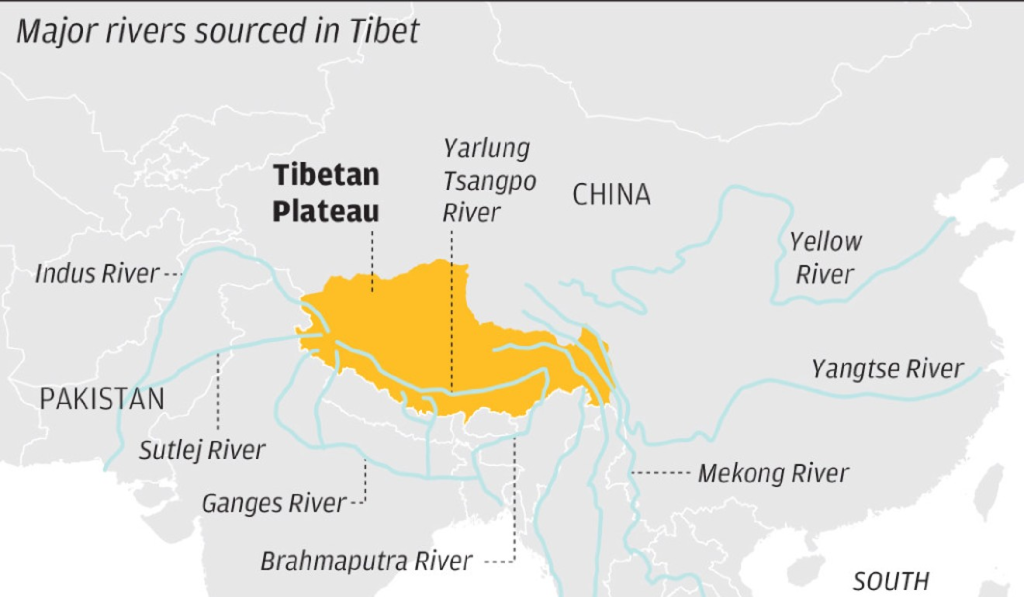John F. Kennedy once said:
A man may die, nations may rise and fall, but an idea lives on. Ideas have endurance. Ideas are inspirational.
Do you not see the Yellow River comes from the sky?
What an unbelievably powerful idea
Hi readers!
Do you believe that Yellow River of China comes from the sky?
You don’t? I also and got to know only when I read the article “Prologue to China” which starts with the above-mentioned poetic phrase by “Li Bai” (of Tang Dynasty) who utter this in 752 AD. Since then, Chinese are making every effort to convert this idea into a practical reality. The current “sky river project” is today’s practical manifestation of that “powerful idea”.
(How may ideas we have been bestowed upon? Have we every tried to pursue them with this spirit?)
Introduction
The desire to control weather is not new and is being manipulated since 1945. Similarly, it is not unique for the people of China. The Sky River “both as conceptual model and the weather modification project” is also to tell the world how actively she is working on her “dynastically powerful idea” to manage her water resources for thousands of years and has been openly developing weather modification technologies since 1950s. As the water consumption of China expended, her desire to build rain making network flourished which is now “three times of the size of Spain”.
One of the technologies used for this purpose is cloud seeding stove: a basic metallic envelope on a pedestal covering over a high-performance combustion chamber like of a military rocket engine which is being used to burn silver and potassium iodide. The stoves are installed on strategically positioned high altitudes where upward winds exhaust the chemical into cloud formations to trigger rain and where physical embodiment of “Sky River” both as phenomenon and as project is seen for the first time and from where Yellow, Yangtze, and Mekong rivers have their origins: the Tibetan Plateau. The Yangtze and Mekong rivers flow through the Southern part of China with plenty of water because of its humid weather while Yellow River mainly flow in the North where frequency of rainfall is comparatively low therefore,
“The aim of the Sky River project is to transfer more water from Yangtze to Yellow river at their points of origin (pl. see the figure below which is self explanatory) using “water vapor transport” supported by cloud seeding and the satellite network”.

This way, more than 5 billion cubic meters rainwater year1 would ultimately flow into the Yellow River to keep it flowing till the end of times. No comprehensive theory or technology can show how precisely China will control the formation of clouds or rains,” as it is only confined to the “scientists who are responsible for helping the government making the right decisions” who also briefed the public accordingly. An irrigation engineer at Qinghai University said,
“the project is already under way as we have our own considerations,” he said, without elaborating.
The massive project aims at producing rainfall over an area of > 1.6 million square kilometers (620,000 square miles), or roughly 12 times the size of England, and has already received about 100 million yuan (US$14.5 million) in funding.
The testing site of the project is Sanjiangyuan province (point of origin of Yellow, Yangtse and Mekong rivers) which creates problems quite often because the stakeholders some time don’t comprehend the abilities of those who explain the project on site through modeling and computation. For them, resolving the conflicts among their hierarchies are more important compared to computers and modeling which is not their forte.
(Think about what happened to our Kala Bagh Dam. China succeeded in her resolve, we could not and that’s the difference)
It is important to note, that in the atmosphere, the transboundary hydro-geologic (physical features that control direction of groundwater flow in a groundwater system) prohibit the flow control based on surfaces, routes, and boundaries rather than on logic of the flows and routes, because they ignore completely that,
“in the areas where essentials of the climate crisis are unfolding and where regulation and conflicts are emerging, it is the atmosphere that produces multiple localities on the ground where these transformations can be observed, and sites of their mediation can be imagined”.
Hydrogeology is the investigation of how groundwater moves through the Earth’s crust, soil, and rock
The atmosphere contains variable amount of water vapor with an estimated volume of about 37.5 million-billion gallons which move into the atmosphere either through evaporation or through transpiration. When the water vapors moved up, they meet aerosols: some of which are hygroscopic (water attracting). In a stable/saturated air, these aerosols pull water vapor to form the foundations of cloud droplets (dew). When such droplet grows in volume, weight, and height, they become a cloud and fall back down toward the surface of the Earth as rain. Some time they become heavy and converted into cloud burst that play havoc on the earth.
The science of clouds, therefore requires an understanding of the entire atmosphere, including all of its dynamics and externalities. Hence,
It is no coincidence that one of the greatest challenges to climate change prediction is inadequate representation of cloud in the processes.
According to new concept of atmospheric water proposed between 2016 and 2018 by scientists from Tsinghua and Qinghai Universities, the water found in rivers, lakes, underground aquifers, and other sources that can be used by humans directly called blue water, Blue water, which directly evaporates from the land surface and transpires from vegetation called Green water while White water is the one that exists when and where moisture with a high potential to precipitate moves into “discontinuities (gaps) in the atmospheric flow creating special boundary layers by air masses which are characterized by different gradients of temperature, velocity, pressure, or humidity upon meeting each other in the troposphere. The engineers and scientists named these gaps as “sky rivers”: specific bodies of tropospheric water filaments that support identifiable spatial and temporal dimensions.
The focus of the previous research on atmospheric rivers in China has remained on the transportation of water vapor and its short-term manifestation in extreme weather events, while attention of “sky river project” is on “long-term configuration infrastructure” of atmospheric rivers so that they may be “fully brought into the water resources management system”.
More next week dear readers to show power of the idea practically.
Till then, keep thinking about the “ideas” one of which will definitely be powerful. Bye






2 Comments
Dr. Kaiser Jamil
March 2, 2023 at 7:52 amInteresting examples to explain the idea.
shafqat
March 4, 2023 at 10:18 amThank you Ma’am